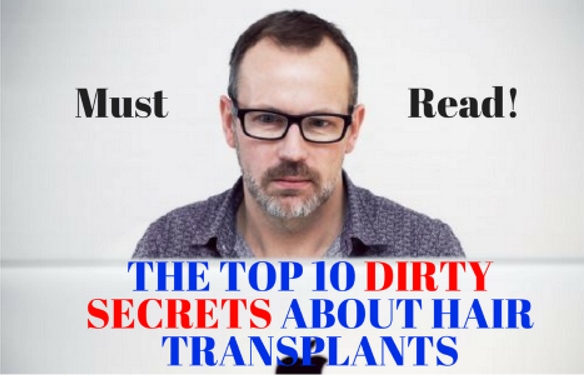Last Updated on June 10, 2020 by Robert Price
Getting a hair transplant could easily be the best decision you ever make in your life. It could also be a total disaster, as President Trump would say. Bad hair transplants are like herpes — they make you less attractive, and they stay with you forever!
So do your research before you go under the knife, ladies and gents. This is a good start. You may as well start your quest for knowledge and truth here, as I provide you the top 10 filthy, disgusting secrets about the hair-restoration field.
There are many good things and benefits to having a hair transplant. This articles focuses on the bad, the despicable, and the ugly aspects of hair restoration. Read it, if you dare. That disclaimer aside, here goes:
The The Top 10 Dirty Secrets About Hair Transplants
#1. You’ll Probably Need More than 1 Procedure

Hair transplants are sort of like Pringles, the chips, in many cases. Their slogan is: “Once You Pop, You Just Can’t Stop.” And similarly, once you pop for one hair procedure, you may find the results unsatisfying and accordingly keep going back for more!
I see clinics advertising “permanent” results all the time, which is true but typically misleading. Hair loss is progressive. So even if you have a successful hair transplant, there’s a good chance you’ll continue to lose hair throughout the course of your lifetime and need more procedures in order to maintain your results.
Most men with “normal” hair loss — i.e. those who don’t look like Dr. Phil or Prine William and just have an average degree of hair loss — can maintain a full head of hair, or at least the illusion of a full head of hair, with 2-3 procedures over the course of their lifetimes, provided they’re on some kind of preventative hair loss treatment regimen.
#2. Beware! Slick Marketing and Sales Techniques are Commonplace

Instead of a doctor, you may talk to a glorified salesman when you go in for your transplant consultation.
When you arrive at your initial consultation with a prospective surgeon, chances are, you’ll talk to a patient “educator” or representative of some kind instead of the surgeon himself. That educator will likely be much more interested in selling you on his or her clinic’s services than they will be in educating you about the actual hair transplantation process.
#3. The Younger (And More Desperate) You Are, The Less Likely You Are to Be Satisfied with Your Results
Younger men are particularly vulnerable to misleading sales pitches and other unscrupulous behavior. Why? Because hair transplants are often ill-advised in cases of aggressive, early-onset hair loss, yet it’s the men suffering from early balding who are usually the most desperate to get their hair back.
Most ethical surgeons will advise against hair transplant to patients under a particular age. For many, the cut-off is 25. Some will work with patients slightly younger than 25. Others, such as Dr. Abraham Armani of Armani Medical, only recommend hair transplantation as a last resort to men in their 20s.
And some surgeons, of course, will operate on any patient with a pulse and a valid credit card! If you’re a bald or balding dude who’s considering letting nature take its ugly course and go bald like God intended, check out the article below…
Also, it should be noted, women rarely make good candidates for transplantation.
#4. There are More Bad Hair Restoration Surgeons Than Good Ones
The same could be said about most other professionals, from landscapers and plumbers to adult-film stars and dentists. With the advent of robotic, FUE technologies, the bar for entry in the hair transplantation field has shrunk dramatically. So not surprisingly, the field is overcrowded with inexperienced and sometimes-incompetent hacks.
#5. There’s No Such Thing as a “Scar-Free” Hair Transplant
This dirty secret is one that never ceases to annoy me. You hear and see it all the time: clinics promising “scar-free” results on radio ads, their websites, billboards, etc. The fact is, no procedure is scar-free, even the popular FUE procedures that many clinics specialize in and promote endlessly.
More:
Some of the worst hair transplant scars I’ve seen are FUE scars. They often take on a “moth-like” appearance around the donor area. Instead of one, ear-to-ear FUT scar, which is typically about the size of a pencil-drawn line, you effectively get hundreds or thousands of 1 mm dots (sometimes bigger).
That’s not to say FUT is a superior technique. Moreover, FUE typically is the preferred method among patients who prefer wearing short hairstyles. But FUE is not a scar-free procedure — that fact is undeniable.
#6. A “Natural Looking” Density May Not Be Possible with One Procedure
The success of your surgery will depend on many factors, including your hair character, degree of hair loss, donor-area characteristics, scalp laxity or looseness, your expectations, and more. So, not surprisingly, many things could hypothetically go wrong during your surgery.
Don’t expect miracles. You may not achieve your desired density in the hairline, or other areas that you opt to thicken/cover. Your result could look incomplete, pluggy, or unnatural. Of course, you should take steps to ensure the best possible outcome of your procedure, but you should also be prepared for the worst-case scenario.
#7. Your Hair “Donor” Area is Quite Small
There is a small area on the back of the scalp, often called the donor or permanent zone, where hairs can be safely harvested for transplanted. I sometimes call this area the “Dr. Phil zone.”
Think of the horseshoe-like band that even the baldest of men maintain throughout their lifetimes, such as Dr. Phil and Larry David. That’s the permanent or donor zone. It’s tiny, relatively speaking!

Dr. Phil’s donor area is still in tact, but he probably doesn’t have enough hair elsewhere to merit having a hair transplant.
Don’t get me wrong. Some super-bald men can achieve the illusion of full coverage via several procedures. Illusion being the operative word. That small donor area can deliver phenomenal, life-changing results, but it has its limitations. That’s all I’m saying.
#8. It’s a Wild West

Instead of a hair transplant, you could take the country singer approach to male pattern baldness and just wear a cowboy hat!
According to the American Hair Loss Association, the hair restoration field is completely unregulated in the US. Any licensed doctor can perform a hair transplant, without any kind of special training or accreditation required. That means, on a whim, any physician can proclaim themselves to be a hair transplant surgeon!
Yeah, this one is disconcerting, to say the least.
#9. It’s Gonna Look Worse Before It Looks Better
Dirty secret #9 isn’t necessarily a secret. However, it’s not a fact that most clinics like to mention as a selling point, that’s for sure. Expect 5+ months of slow, awkward regrowth as your new hairs begin to sprout. Full results won’t come for a full year.
#10. Recovery Can be Painful (and a Pain in the You Know What, Too)
Common post-surgery complaints include excessive swelling, scabbing, and general discomfort. After your transplant, there’s a pretty good chance you won’t get much rest for the first few nights, as well. Your doctor will likely recommend a special sleeping “position” that minimizes swelling but is not conducive to sleep.
Big drinker? Sorry, you’ll probably need to abstain from your nightly habit for at least forty-eight hours.
Exercise could be another issue. If you went the FUE route, chances are you’ll be able to get back into your routine fairly quickly. FUT requires more downtime, as the scar could expand and get all Jeremy Piven-y on you if you start pumping the iron too soon. Talk to your doctor, as always. Expect to skip working out all together for a week or so, then after that, proceed with caution. It could take up to a month (or more) before you can safely resume your program.
#11 (a Bonus, Free of Charge) – You May NEED to Take Propecia…
Propecia, AKA finasteride, is the highly effective and controversial hair loss medication that can often stop or dramatically slow the balding process. Trump takes Propecia. If that doesn’t give you some pause, I don’t know what will.
If you’re really going bald, a hair transplant alone is probably a terrible idea. You’ll keep losing hair in the areas surrounding your transplant and ultimately end up looking WORSE as a result of your transplant, not better. Buyer be warned! Check out the article below for more information on Propecia. Educate yourself on this drug before you consider a transplant.
Closing Thoughts – Dirty Secrets About Hair Restoration Surgery
Information is power, whether you’re a philosopher, welder, male prostitute, or hair loss sufferer. Information is especially important (and powerful) if you’re a balding male prostitute who relies upon his boyish good looks! But I doubt that’s the case.
Anyway…before you get a hair transplant, you should definitely be aware that you’ll probably need more than 1 procedure, and that slick marketing tactics are omnipresent (young, desperate people are particularly susceptible to such tactics). And as I said, there are way more bad hair restoration surgeons than good ones, sorry!
Here’s more terrible news:
- Your donor area is tiny,
- The industry is ridiculously unregulated.
- And the recovery process after a hair transplant is more of a pain in the behind than most people realize.
I could go on. I didn’t even cover every dirty secret about the hair loss industry that I mentioned in my top-10 list. Hopefully this was informative and not too much of a bummer for you.
The silver lining is this: Good hair transplants are totally undetectable! And there are many reputable, honest surgeons out there. So before you go under the knife, you just have to do your homework and make sure you choose a qualified and skilled doctor.
Robert Price is a writer, consumer advocate, and hair loss researcher with thousands of hours of experience in the field. His goal is to keep you out of the hair loss rabbit hole, underworld, or whatever you want to call it. He founded Hair Loss Daily, the unbiased hair loss blog, in 2016. You can learn more about Robert in the my story section of this website.







I can’t think of one good reason (or any reason, for that matter) for putting myself through the physical and financial torture of hair transplants. On the contrary, I would love to know how to expand from Norwood 6 to Norwood 7 MPB and how to rid myself of the last of the nearly invisible but still pesky fuzz that I still grows on top of my head. In other words, I am 99% satisfied and happy with how bald I am, but would love to complete the transformation. I still envy Dr PHil and other Norwood 7 bald men I see. At my church there are at least a dozen Norwood 7s and I am one of at least 50 Norwood 6s. It is a large church with many mature men members like me.
The hair restoration ‘expert’ I visited when I first realized that I was going bald told me that if his ‘remedies’ didn’t work and I continued to go bald, my best option would be hair transplants. I blanched at the cost and shuddered at the pain and discomfort and pain I would have to endure. I thanked him for the information, the diagnosis and his advice, and left. But I left relieved that I would not have to bother with cures or transplant procedures. Mostly, I left feeling ecstatic about the prospect of rapidly going bald. And I wasn’t disappointed. I can live happily as a Norwood 6. Going Norwood 7 would just be ‘icing on the cake’.